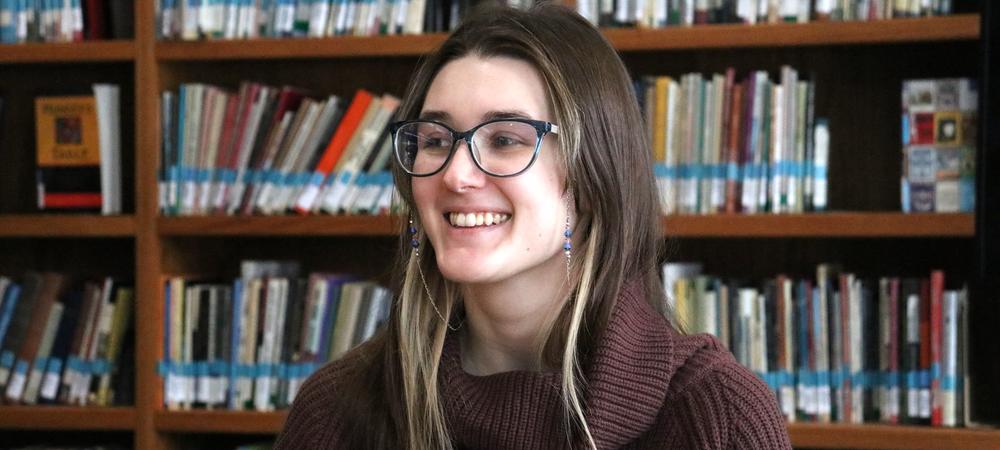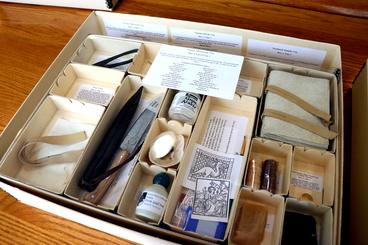
When Olivia Kingston ’23 first came to UMN Morris, she didn’t know much about medieval and ancient studies, never mind that she could earn a degree in that field. She’d planned to pursue a degree in French. But after taking a French introduction to medieval studies class from Associate Professor Lisa Bevevino, she was so fascinated and intrigued by what she learned that she wanted to explore the program more. And with encouragement from Bevevino, she ultimately decided to major in both French and medieval and ancient studies. She found that the two majors complement each other.
Kingston welcomed the opportunities she had as a UMN Morris student to gain hands-on experience. One opportunity was a unique manuscript project. The university had been collecting historical writing and manuscript materials over the last few years under Bevevino’s direction, and it had been Bevevino’s goal to organize the materials in a way that others could view them and learn from them. She asked Kingston if she’d be interested in taking on the project as a scholarly and creative project, and Kingston eagerly agreed. Bevevino was able to acquire funding for the project through the Morris Academic Partnership program with a set number of hours and from there, Kingston set to work.
The result is a detailed, intricate collection of modern paleography materials in organized, easy-to-view display boxes with well-thought-out captions and simple instructions. Now, anyone who examines the displays can see and learn what all went into making an ancient manuscript.
“Olivia took it upon herself to put information within each box that people can read… she really thought about… who is this serving,” says Bevevino.
When asked how she feels about the finished product, Kingston says, “I feel ecstatic and happy, super bubbly just looking at it and seeing it being used, it’s really cool.”
It was by no means a simple task. Kingston admits to feeling somewhat overwhelmed at first by the scope of the project and all of the materials. “Originally looking at it, it was a lot to take in, but it definitely was a fun challenge, a great experience,” she says. With just two reference books and hundreds of items in one container, Kingston was given the creative freedom to organize them in a way that would make sense to someone who was looking to reproduce an ancient manuscript in modern times—an exceptionally complicated task, according to Bevevino. Kingston knew, however, that she could always ask questions and look to Bevevino for guidance, in addition to their regular check-ins.
“I really enjoyed how much [I was] able to explore my creative freedom within, even just the hands-on experience. For my career path—I’m going into library sciences—this is a foundation to support that [and be] able to look into texts more deeply,” says Kingston. She specifically points out the experience gained from cataloging, touching, moving, and being present with the materials, formatting the boxes, and figuring out all of the intricate details for the project.
Both Kingston and Bevevino agree that this learning experience results in a skillset that will not only benefit Kingston as a future librarian, but will serve her well in any job, regardless of where her career path takes her.
“There were so many moments that she learned and excelled. She’s accomplished so much,” says Bevevino.
Kingston adds, “[It’s a] very great feeling.”
Project Will Benefit Future Medieval and Ancient Studies Students
The completed paleography project allows future medieval and ancient studies students to see—and feel—the craft of making manuscripts. Instead of just reading a modern copy of a manuscript, students can actually make one—a truly hands-on experience that could be important in their future work. And they can take part in similar projects as Kingston.

Bevevino points out that the displays will have a real impact on how future students learn or do research in the field of medieval and ancient studies. These students, she says, will have proven that they can work with ancient materials responsibly.
“Students gain the experience to work with these modern materials—they’re not going to damage them. They can move on to work responsibly with cataloged and uncatalogued sources,” says Bevevino.
The paleography displays are presented in a way that, Bevevino says, humanizes a time period for which a lot of information is missing. She anticipates that the displays will better enable students to really think about every item that went into making a manuscript in ancient times and what the implications were for the people of that time. “[They allow] your brain to move through the questions.” She hopes the project “(i)nvites others to answer questions not yet answered.” Such questions center around the materials and how they were acquired, who touched them, who benefited and who didn’t—ultimately, questions about cost. “Cost, in my mind, is always there,” says Bevevino.
The paleography displays that Kingston worked on are one of three types of collections at UMN Morris for medieval and ancient students to access and learn from. The other two collections are leaves—authentic pages from manuscripts—and facsimiles, colored photos of actual manuscripts, published and bound as books. All are available for students to study and work with.